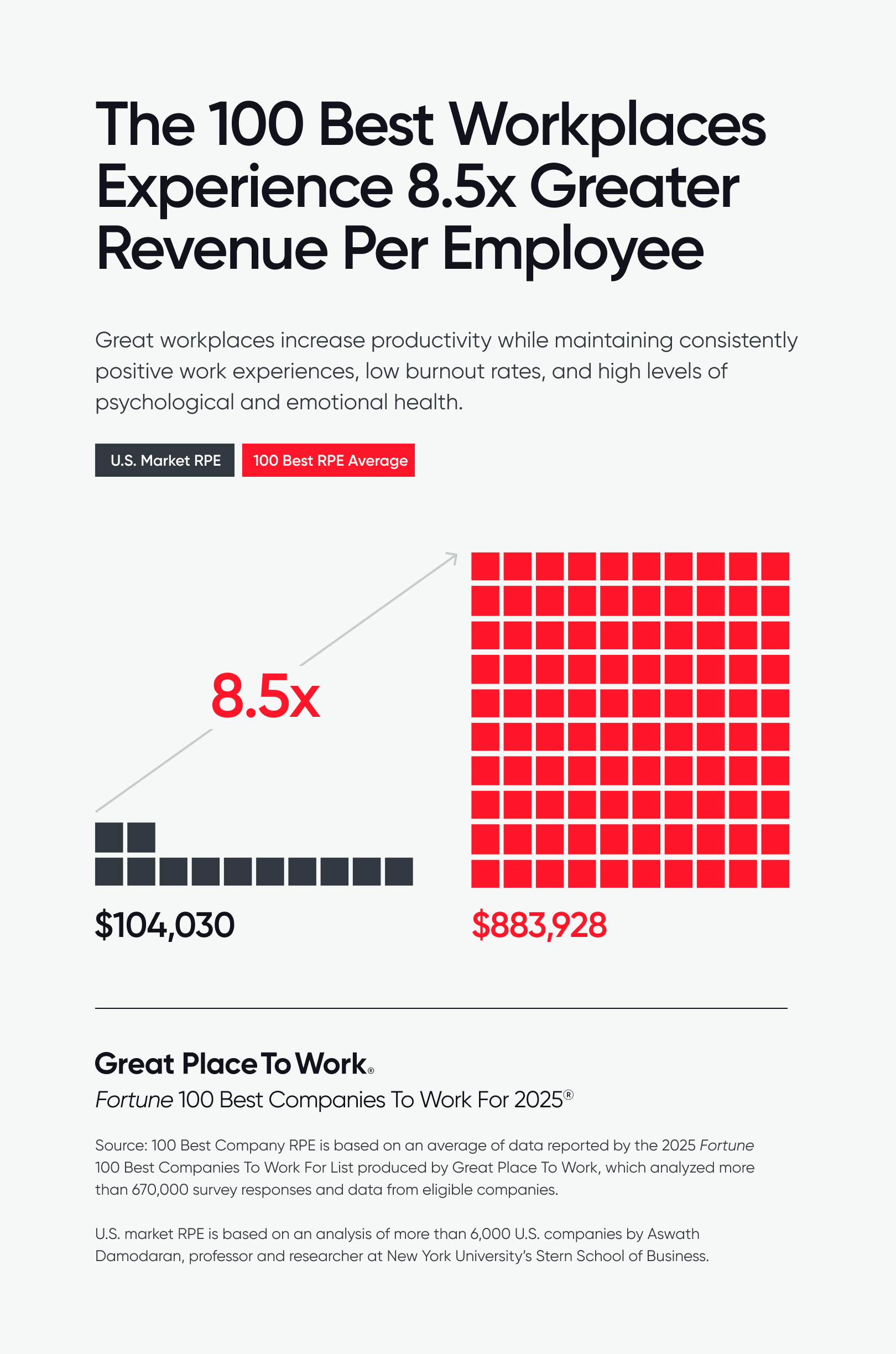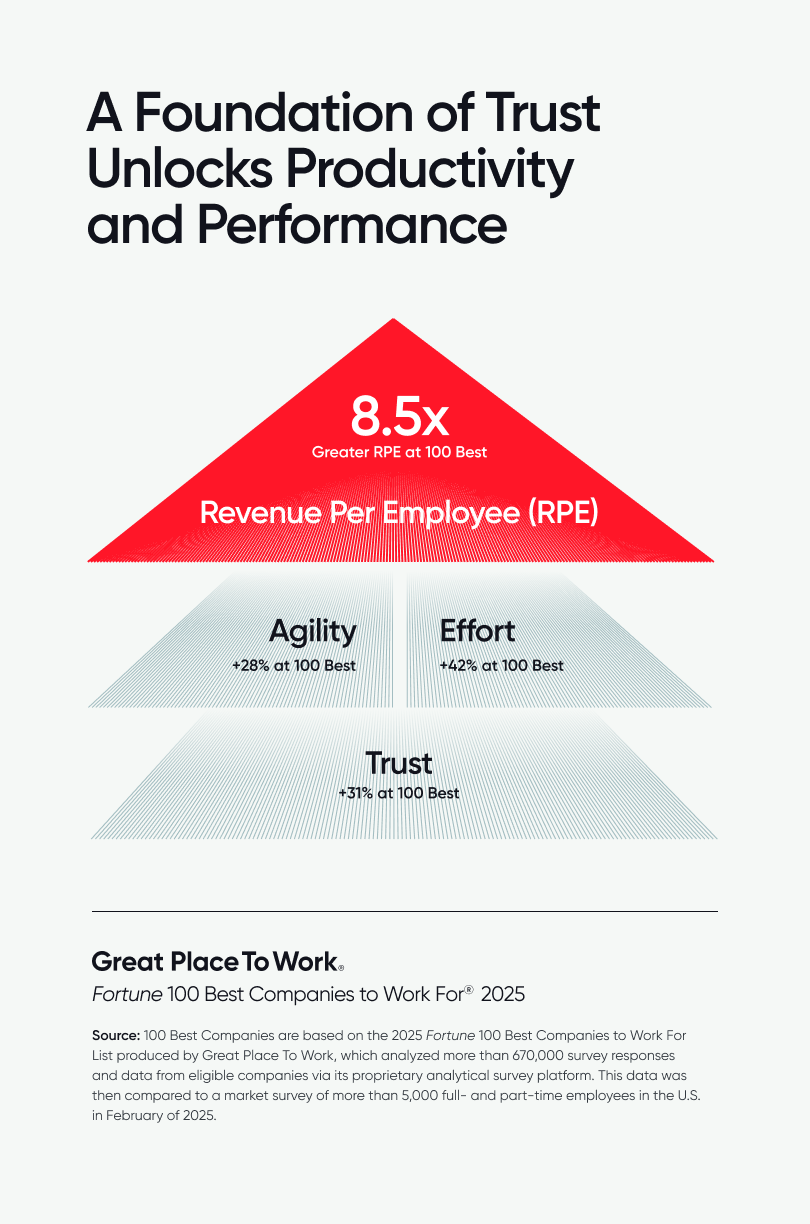Benefits of Company Culture, Elements of Company Culture, Productivity
Here’s how the Fortune 100 Best Companies outperform the market on a key measure of efficiency and profitability.
Companies across industries have pivoted from the frenzied hiring of the post-pandemic era to questions about efficiency.
Nearly half of managers said layoffs were likely at their company this year, per a January survey. Companies of all sizes are looking to do more with less, leverage technology to increase productivity, and trim costs.
If your company isn’t actively trying to shrink its workforce, a smaller team might still be on the horizon as a mass retirement wave is predicted in key frontline sectors around the world.
Which companies are ahead of the curve on productivity and efficiency? The 2025 Fortune 100 Best Companies to Work For® have 8.5 times the revenue per employee (RPE) compared to the U.S. public market RPE.

What is revenue per employee and why does it matter?
Revenue per employee is the ratio of a company’s revenue divided by the total number of employees generating that revenue. For example, if you have revenues of $1 million and a workforce of 100 employees, your RPE is $10,000.
This simple metric can be used by companies of any size to answer a simple question: Am I getting enough value from the talent working for my company?
For most companies, this is an existential question. In analysis from McKinsey across eight major industries, companies spend at least three times as much annually on talent compared to capital expenses like machinery or facilities.
As a result, RPE becomes a meaningful indicator of profitability. Although it doesn’t capture the full picture, it’s a valuable tool for understanding efficiency across your workforce, when weighed in concert with other metrics.
Why great workplaces have higher RPE
The Fortune 100 Best Companies to Work For — a list of 100 organizations selected by Great Place To Work® based on employee survey data — represents a group of companies with the highest levels of employee trust in the U.S. as measured within the Great Place To Work Model.
These high levels of trust result in stronger business performance compared to typical workplaces. Great Place To Work compared the revenue per employee of the 2025 100 Best Companies against data collected by Aswath Damodaran, a professor and researcher at New York University’s Stern School of Business.
The result? The 100 Best companies have an average RPE of $883,928. That’s 8.5 times higher than the $104,030 companies in the public market typically see per employee, according to data from 6,000 companies collected by Professor Damodaran from public sources like Bloomberg, Morningstar, and the S&P 500. This gap cannot be attributed to factors like industry, or whether a company is publicly traded or privately held. In each industry, a significantly higher RPE was seen for the 100 Best. When looking at just publicly traded companies on the 100 Best, they had an RPE number 9.4 times the market, and private companies were close behind with an RPE 7.7 times higher.
The upshot? Regardless of industry, structure or ownership, high-trust workplaces have a much stronger RPE, indicating higher levels of productivity and performance.
Just look at the 100 Best, which over the past 26 years have outpaced the stock market by a cumulative factor of 3.5 times.
Making RPE sustainable
There are temporary ways to inflate your RPE numbers. Cut a large number of workers and suddenly it looks like your workplace is much more efficient on paper.
That’s not how the 100 Best do it. While they might conduct layoffs — an unfortunate, but sometimes necessary part of doing business — Great Place To Work data shows that something else is happening that drives sustained long-term performance at these companies.
“What you see is that leaders have a clear direction for the company,” says Sarah Lewis-Kulin, vice president of global research and recognition at Great Place To Work. “People are encouraged to innovate and find better ways of doing things, and there’s great communication.”
A combination of agility and effort drives efficiency and performance, resulting in more revenue generated per employee.

A foundation of trust unlocks the full potential of your workforce. At the 100 Best, 84% of employees say they can count on people to cooperate, a 29% increase over the typical U.S. workplace.
At great workplaces, a cooperative culture is one where promotions and recognition are awarded fairly and transparently. Employees have shared definitions of success, and open communication around company goals and expected behaviors. They can find a mentor who takes time to help them develop. They get support to try new ideas and are inspired to take on stretch assignments and take risks.
This creates a sense of purpose, an understanding that one employee’s success doesn’t come at the expense of someone else on the team. Instead, employees feel they have the tools to participate fully in a shared mission — and trust that their contributions will be celebrated and rewarded. People offer to help get a project across the finish line, even when the task at hand isn’t in their job description.
That’s why when employees say they can count on cooperation, they are a staggering 720% more likely to give extra effort on the job.
Why you should connect RPE to employee survey data
While revenue per employee can be affected by external factors, from supply chain costs to a changing economic climate, leaders should consider their workplace culture as a crucial driver.
Start by surveying employees, and use data to identify opportunities for building trust and unlocking potential across your workforce.
“This research emphasizes just how critical it is to invest in great leaders who can move your people and your business forward,” says Karina Monesson, director, global strategic workplace insights at Great Place To Work. With employee survey data broken down by leader, you can identify where employees are thriving or barriers that suppress team performance.
Do employees have a manager who is invested in developing them? Is there frequent communication about company priorities and long-term goals? Do they understand what is expected of their role and how it contributes to the bottom line?
“That all starts with managers,” Monesson says, with the nine high-trust leadership behaviors offering a playbook for improving leadership across the organization.
Another place to look is access to innovation and engaging more employees in “jumping the S curve” or growth. Great Place To Work research found that when employees at all levels of the organization have the opportunity to try new things and participate in developing new ideas or products, companies had 5.5 times the revenue growth of their less inclusive peers.
That might be one reason why employees are 60% more likely to give extra when every employee can receive special recognition for their work. As more employees have the opportunity to take risks and contribute new ideas, regardless of outcome, the number of employees going above and beyond in the organization increases.
Another key driver? Having meaningful work makes employees 50% more likely to give extra. Again, innovation often provides employees the chance to have a tangible impact, and become more connected to the deeper mission of an organization.
There are plenty of other factors responsible for these experiences in the workplace, Lewis-Kulin warns. However, for companies looking to revitalize their culture, these can be good places to start.
Get recognized for your culture
Gain accolades for your workplace environment and attract top talent who share your values.











